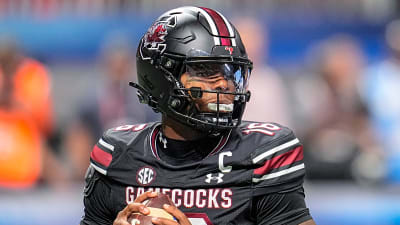When you’re leading an offense averaging nearly 352 passing yards a game, you’ve earned the right to rock a chain, and even pack a lip, on the sideline. Nebraska offensive coordinator Dana Holgorsen has done that and more in 2025. Now, as I did with the defense, it’s time to compare how, through four games this fall, the Huskers’ offense stacks up to last year’s. Entering his ninth game as Nebraska’s play-caller, here’s how Holgorsen’s unit measures up to the 2024 season averages across a range of offensive stats.
1. Passing Stats
By every metric, Nebraska’s passing attack has taken an impressive leap from a season ago. Through four games, the Huskers are averaging over 123 more passing yards per game than in 2024, ranking just two spots behind the nation’s top aerial offense. They’re also gaining 9.3 yards per attempt, an improvement of 2.5 yards per throw over last fall. Husker quarterbacks have also combined for 118 completions, connecting with receivers at a rate nearly 12% higher than a year ago.
Sophomore quarterback Dylan Raiola is quickly emerging as one of the country’s most efficient passers, landing near the top of several key categories through the month of September. The one glaring concern is pass protection. After allowing 28 sacks in 13 games last year, Nebraska’s offensive line has Raiola on pace to be sacked 33 times this season. The passing game has been a welcome surprise, but unless protection improves, it could limit the offense’s ceiling.
2. Rushing Stats
Despite a tough day on the ground in their last outing, Nebraska’s rushing attack is performing better than many might assume. At 4.2 yards per carry, the Huskers are averaging 0.4 more yards per attempt than last season. They’re also dead even in rushing attempts per game (34.5) compared to 2024, despite the perception that the offense has shifted away from the run. While passing plays do outnumber runs, that’s more a reflection of Nebraska’s improved success in sustaining drives, and thus running more total plays, than a decreased emphasis on the ground game itself.
With attempts per game holding steady, the added 0.4 yards per carry has translated into 14 more rushing yards per game. Still, as conference play ramps up, the Huskers will need more consistency in the run game to reach their season goals. Finding a reliable second back will go a long way toward that effort, and if they can do so, the offense should be in good shape moving forward.
3. My Interpretations
The Dylan Raiola effect is alive and well in Lincoln, as Nebraska’s offense has taken a clear step forward. Not only are the Huskers piling up points and yards, but their improved production is also easing some of the pressure that’s long rested on the defense’s shoulders. While the current scoring pace may cool as the season goes on, this offense looks capable of keeping Nebraska competitive in every game, leaving it up to the defense to do its part.
In this article, I highlighted six key offensive metrics, with only one being worse than last season’s numbers. That alone shows just how far the unit has come. The road ahead will only get tougher, but the partnership between Holgorsen and Raiola has sparked an attack that’s difficult for opponents to slow down. If the ground game ever finds more consistency, Nebraska could field one of the nation’s most complete offenses.
There’s plenty of season left, so we’ll revisit these numbers down the road, but for now, Husker fans can feel something they haven’t in a long time — genuine confidence in their team’s offensive identity.
More must-reads:
- Scott Woodward out as LSU AD a day after scathing criticism from Louisiana governor
- Why Penn State should root for an early end to Texas A&M's season
- The 'NFL passer rating leaders' quiz
Breaking News
Trending News
Customize Your Newsletter
 +
+
Get the latest news and rumors, customized to your favorite sports and teams. Emailed daily. Always free!








